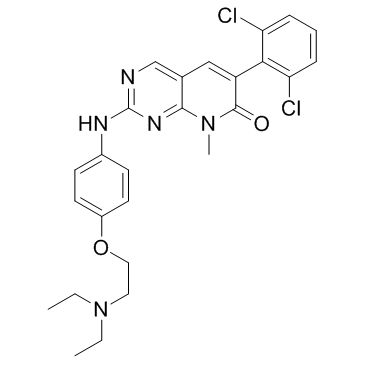185039-89-8
| Name | PD166285 |
|---|---|
| Synonyms |
PD166285
TCMDC-140940 6-(2,6-Dichlorophenyl)-2-({4-[2-(diethylamino)ethoxy]phenyl}amino)-8-methylpyrido[2,3-d]pyrimidin-7(8H)-one Pyrido[2,3-d]pyrimidin-7(8H)-one, 6-(2,6-dichlorophenyl)-2-[[4-[2-(diethylamino)ethoxy]phenyl]amino]-8-methyl- 6-(2,6-Dichlorophenyl)-2-[[4-[2-(diethylamino)ethoxy]phenyl]amino]-8-methylpyrido[2,3-d]pyrimidin-7(8H)-one PD0166285 |
| Description | PD0166285 is a WEE1 inhibitor and a weak Myt1 inhibitor with IC50s of 24 and 72 nM, respectively. |
|---|---|
| Related Catalog | |
| Target |
IC50: 24 nM (WEE1), 72 nM (Myt1)[1] |
| In Vitro | PD0166285 is a pyridopyrimidine class of molecule. At the cellular level, 0.5 μM PD0166285 dramatically inhibits irradiation-induced Cdc2 phosphorylation at the Tyr-15 and Thr-14 in seven of seven cancer cell lines. PD0166285 sensitizes radiation-induced cell killing in p53 mutant HT29 cells and in the E6-transfected, p53-null ovarian cancer cell line PA-1 but to a lesser extent in p53 wild-type PA-1 cells. PD0166285 abrogates irradiation-induced G2 arrest and significantly increases mitotic cell populations. Biologically, PD0166285 acts as a radiosensitizer to sensitize cells to radiation-induced cell death with a sensitivity enhancement ratio of 1.23[1]. |
| Cell Assay | For PA-1 cell clonogenic assay, growing cells are irradiated with the indicated dose of γ-radiation (2–8 Gy). Cells are subsequently cultured in the original medium for 12 h, followed by treatment of 0.4 μM PD0166285 or DMSO control for another 4 h[1]. |
| References |
| Density | 1.3±0.1 g/cm3 |
|---|---|
| Boiling Point | 665.3±65.0 °C at 760 mmHg |
| Molecular Formula | C26H27Cl2N5O2 |
| Molecular Weight | 512.431 |
| Flash Point | 356.2±34.3 °C |
| Exact Mass | 511.154175 |
| LogP | 5.09 |
| Vapour Pressure | 0.0±2.0 mmHg at 25°C |
| Index of Refraction | 1.637 |
| Storage condition | -20℃ |
| Water Solubility | Insuluble (4.9E-4 g/L) (25 ºC) |
